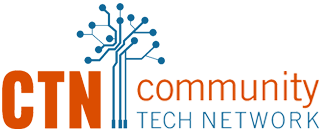On a day that saw San Francisco fill with 25,000 librarians for the American Library Association Conference, Community Tech Network and Zero Divide hosted an intimate forum on digital inclusion with special guest Karen Archer Perry.
Karen is the principal consultant for digital, community, and policy programs at the Clarion Collaborative. Quizzed by Community Tech Network’s Executive Director Kami Griffiths, Karen shared her considerable experience and insights with the attendees.
A full recording of the event can be accessed here.
WHAT’S DIFFERENT NOW
Karen shared what has changed since she began working in the field in 2006.
- A change of attitude about digital inclusion. Now we realize that while digital is personal, inclusion also affects whole communities and populations.
- Ubiquity. Nowadays, people have several devices and Internet access points in the home and elsewhere, meaning that broadband adoption in the home is now an insufficient measure of connectivity.
- The skills gap has replaced tech access as the key challenge of connectivity. Karen pointed to the Mozilla Web Literacy Model, which includes attributes to help people explore, connect, and build on the web.
INCREASING DIGITAL INCLUSION
Kami asked why digital inclusion, which has grown in importance, isn’t given greater priority by funding agencies. Karen felt that digital inclusion is integral to many programs but is sometimes seen as a standalone issue for funders, who don’t necessarily see it as part of their mission. It is also difficult to measure and communicate the outcomes and opportunities, or causes and effects, of digital inclusion work. However, President Obama’s recent initiative — the Broadband Opportunity Council — may help push the issue higher up on government and foundation agendas.
When asked what digital inclusion success looks like, Karen talked about the importance of social infrastructure. She cited one program involving farmers on a Navajo reservation who were given digital tools to help raise farm productivity. Those who took to the technology were those who had a friend to help them. On this point, Karen quoted Kentaro Toyoma, who works for Microsoft: “Technology doesn’t cause fixed benefit; rather, it amplifies the underlying human forces,” meaning that the tech is only as good as the social infrastructure that surrounds it.
Karen had three pieces of advice on how to increase corporate involvement in digital inclusion effort.
- Appeal to enlightened self-interest (digital inclusion probably helps you achieve your mission or expand your market)
- Think big (take inspiration from highly impactful service revolutions such as Uber).
- Be specific (tackle one thing well so that its impact can be measured).
Kami referred to Twitter’s new NeighborNest as a good example of specificity.
Finally, Kami asked what might change if we achieved full digital inclusion. Children have the most to gain, and Karen referred to recent comments by the FCC Commissioner regarding the “homework gap,” which affects children who aren’t properly connected at home. Karen fears that when the figure for broadband exclusion dips below 10 percent, it will cease to be a priority. She would like to see a better system of “linked investment” in which a government department reinvests the savings made from shifting to online services into digital inclusion programs.
OPEN DISCUSSION
Issues raised during the open floor discussion:
- The growing (and as yet unresolved) problem of personal data and privacy. Karen believes we owe it to people to inform them about the bad as well as the good outcomes of using technology.
- Technology tools developed by and for communities. For example, DC’s Code for Progress.
- Inadequate digital literacy education in state schools and the changing definition of access, which for many young people is limited to smartphones. There is a notable lack of national youth digital inclusion standards.
- The challenges of digital inclusion in the healthcare sector. UCSF is doing great work.
- A general skills gap among U.S. adults undermines attempts to grow digital skills.
- Broadband Opportunity Council’s public comments are available on the NTIA website.
- The Department of Better Technology.
- City of San Francisco’s connectivity report. Karen believes such reports can be successful with lots of good data and outreach, citing Seattle’s report, Digital Equity.
- The lack of data (and the difficulties of collecting data) that explicitly demonstrates that participation in digital inclusion programs leads to employment. Data is often biased and unsatisfying, partly because it’s impossible to get a control group since broadband access is integral to most people’s lives.


Comments are closed.